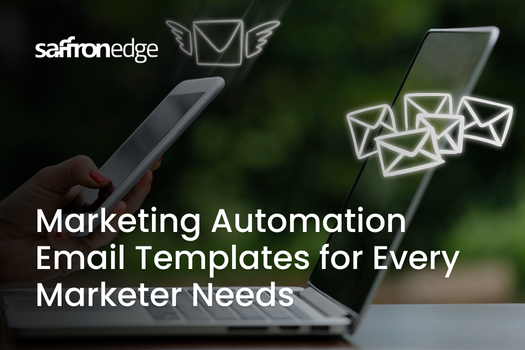A lack of email automation means your marketing team could miss important opportunities to nurture and engage your target audience and contacts.
One of the most impactful tools available to marketers today is email automation.
According to Radicati , the global email user base totals 2.6 billion, with Facebook accounting for about two-thirds of that number. Adobe's research indicates that we're dedicating 17% more time to our inboxes this year than last year.
Automating email workflows can significantly enhance your email marketing strategy by delivering personalized, timely, and relevant messages to your subscribers.
This blog post will explore email workflows, their benefits, how to set them up, and some examples of automated email workflows that can boost your marketing efforts.
What is an Email Marketing Automation Workflow?
An email marketing automation workflow consists of emails automatically sent out based on specific actions or conditions a marketer determines.
Essentially, it’s a predefined set of emails designed to nurture leads, engage customers, or drive specific actions based on user’s interactions with your brand. This email marketing workflow is tailored to guide subscribers through their customer journey, maximizing engagement and conversion rates.
For example, suppose customers sign up for your newsletter. In that case, they might receive a welcome email as the first step in a workflow, followed by emails providing value, promoting products, or encouraging further engagement.
Unlike traditional email marketing, where each email is sent manually, email workflow automation enables you to schedule emails automatically according to user behavior, preferences, or other predetermined criteria.
This ensures that every email is relevant to the recipient, boosting engagement and conversions. Incorporating marketing automation services can help streamline the process of personalizing content and segmenting audiences effectively.
The Benefits of an Automated Email Workflow

Automated email workflows offer numerous advantages for businesses seeking to streamline communication with their audience and optimize their marketing efforts.
By leveraging the power of automation, companies can deliver timely, personalized messages while nurturing leads and driving conversions. Let's see how email automation can benefit marketers:
1. More Seamless Workflow
Email automation enables marketers to efficiently send emails to their customer base, freeing up time for other responsibilities while meeting customer needs.
According to 49% of sales and marketing professionals , time saved on repetitive tasks is one of the top three benefits of automation. Additionally, 45% listed enhanced efficiency and return on investment as another advantage.
2. Better Customer Experience
43% of marketing professionals believe that the primary benefit of employing marketing automation is improving customer experience.
Automated emails efficiently send customers engaging content, including incentives, useful reminders, and introductory information
A well-structured customer onboarding workflow can further enhance this process by ensuring new customers are effectively welcomed and educated through automated email sequences.
Consistently engaging with your customers fosters improved relationships, enhances retention rates, and generates additional leads.
3. Improved Email Segmentation
Email marketing automation simplifies categorizing recipients according to their characteristics, actions, and interaction levels. This boosts engagement, the rate at which emails are opened, the conversion rate, and the rate at which recipients click through the content.
4. Fewer Errors
Mistakes can still happen even when using copy-pasting or templates for your emails.
Email automation allows you to map unique user variables to appropriate template sections and instantly dispatch personalized emails.
5. Improved Personalization
Automated workflows enable businesses to deliver targeted and relevant content to segmented audiences based on their behavior and interactions, enhancing customer engagement and driving higher conversion rates.
6. Enhanced Efficiency
Email automation workflows save time and resources by streamlining repetitive tasks such as sending welcome emails, follow-ups, and personalized messages, allowing businesses to focus on more strategic aspects of their marketing campaigns.
7. Enhanced Lead Nurturing
Automated email workflows are pivotal in lead nurturing automation by intelligently delivering personalized content based on subscriber actions and interests.
Businesses can effectively guide leads through the sales funnel by automating the delivery of relevant information at various stages of the customer journey and by maintaining ongoing communication with existing customers through targeted email campaigns, ultimately increasing the likelihood of conversions.
8. Data-Driven Insights
Automated email workflows provide businesses valuable data and analytics regarding email performance, subscriber behavior, and overall campaign effectiveness.
By leveraging these insights, businesses can make informed decisions, optimize their email marketing strategies, and tailor their content to better resonate with their audience.
Let’s break through your revenue hurdles
We find your primary growth blockers, build expert-led strategies, and provide custom data-driven solutions to help you hit your revenue goals.
How to Automate Email Workflows?
Setting up automated email workflows might seem daunting initially, but with the right tools and a strategic approach, you can easily automate your email marketing.
Here’s a step-by-step guide to setting up an email workflow automation:
1. Select Email Automation Software
Choosing the right email automation software is the process's first and most crucial step. Numerous email marketing automation tools are available, each offering unique features and capabilities.
For this example, we’ll focus on HubSpot’s Marketing Automation tool, but depending on your needs, other options, such as Moosend, Versium Reach, and Mailchimp, are also worth considering.
2. Identify Your Audience
Before setting up your email workflow automation, define who you want to target. Segmentation is key here—you might segment your audience based on lifecycle stages, behaviors, or specific actions they’ve taken on your site.
- Conduct market research to understand industry trends, competitors, demographics, and behavior patterns.
- Define your ideal customer by creating a detailed profile including age, gender, location, interests, priorities, and challenges.
- Analyze customer data to identify demographics, purchasing behavior, and interest patterns.
- Refine your ICP (ideal customer profile) based on analysis and develop targeted messaging and outreach strategies. Utilize segmentation and personalization for more effective communication.
Marketing automation tools such as HubSpot enable audience segmentation so that each recipient receives the most appropriate content.
3. Define Your Email Campaign’s Goals
Understanding your campaign goals is essential for creating an effective workflow. Defining your goal helps craft messages that guide your audience toward the desired action.
Also, ensure your automation setup can adjust when a goal is achieved—for example, unenrolling a customer who has already purchased.
Here are the key questions to ask yourself to define your email campaign's goals, informed by the information retrieved from the search results:
- What do you want to achieve from your email campaign?
- How does the email campaign align with your marketing goals and business objectives?
- What are the appropriate metrics and key performance indicators (KPIs) to measure the success of your email campaign?
- How can you personalize your messaging and segment your audience to align with your campaign goals?
- What past performance data can be used to inform your email campaign goals?
Determining the goals and objectives of emails with the help of a marketing automation specialist is essential for success.
4. Set Enrollment Criteria
Enrollment criteria determine which contacts enter a specific workflow.
Depending on your tool, you might set criteria for new subscribers, abandoned cart users, or customers who have clicked on specific links.
For example, HubSpot allows for multiple triggers, including form submissions, page views, and contact properties. Leveraging the best email marketing automation tools can significantly enhance marketing automation strategies .
5. Choose Which Processes to Automate
Sales process workflows can be highly customizable. Decide which actions you want the software to automate, such as sending follow-up emails, updating customer information in your CRM, setting reminders, and more. These automated processes ensure seamless and consistent communication with your audience.
6. Create Your Email Campaign Assets
Now that you have a plan, it’s time to create your email assets—this includes drafting the emails, creating compelling subject lines, designing templates, and adding CTAs. Ensure all content is aligned with your campaign goals and provides value to the recipients.
7. Test Your Email Workflow
Before going live, always test your workflow. This can assist you in identifying some of the mistakes or inconsistencies that may impact the campaign's success.
Test everything, from the content and links to the sequence of emails and triggers, to ensure it works as expected.
8. Launch and Monitor Your Workflow
Once you’re satisfied with the setup, make your workflow live. Monitor its performance closely, looking for any anomalies or areas for improvement.
Email automation is not a one-time setup—it requires continuous optimization based on performance data.
Working on these steps in marketing automation integration is essential for maximizing the potential of SaaS marketing automation tools.
10 Email Marketing Automation Workflow Examples
Here are a few practical examples of automated email workflows that can help you achieve different marketing goals:
1. Welcome Email Workflow
Trigger: When a new subscriber joins your email list.
Objective: To introduce your brand and set expectations.
Details: Send emails that welcome the subscriber, share your brand story, and highlight key products or services. You can also include a special offer to encourage a first purchase.
2. Lead Magnet Delivery Workflow
Trigger: When a user signs up to download a lead magnet (e.g., eBook, whitepaper).
Objective: To deliver the promised content and nurture the lead.
Details: After delivering the lead magnet, follow up with educational emails that provide additional value and guide the lead toward the next step, such as booking a demo or consultation.
3. Free Trial Sign-Up Workflow
Trigger: When a user subscribes to your website or downloads your product or service for a free trial.
Objective: To guide the user through the trial period and encourage conversion to a paid plan.
Details: Send onboarding emails with tips and tutorials, followed by emails highlighting the benefits of upgrading to a paid plan before the trial expires.
4. Re-Engagement Workflow
Trigger: When a subscriber has been inactive for a specific period (e.g., 3 months).
Objective: To re-engage inactive subscribers and prevent churn.
Details: Email a compelling offer, such as a discount or exclusive content, to reignite interest. If there’s no response, follow up with additional emails to re-engage or gracefully unsubscribe the inactive user.
5. Abandoned Cart Workflow
Trigger: When a customer has selected products but doesn’t complete the purchase.
Objective: To recover potentially lost sales.
Details: Send a reminder email shortly after the cart is abandoned, offering assistance or a discount code to encourage completion of the purchase. Follow up with additional reminders if necessary.
6. Replenishment Workflow
Trigger: When a customer’s product is likely to run out based on purchase history.
Objective: To encourage repeat purchases.
Details: Send an email reminding customers to reorder their products before they run out. Include a convenient “one-click” reorder button and a special offer for loyal customers.
7. Lead Nurturing Workflow
Trigger: When a lead engages with specific content, such as visiting a pricing page or downloading multiple resources.
Objective: To nurture leads through the sales funnel.
Details: Create emails that provide additional information, case studies, and testimonials relevant to the lead’s interests, gradually guiding them toward a sales conversation.
8. Onboarding Workflow
Trigger: When a new customer makes their first purchase or signs up for a service.
Objective: To ensure a smooth and successful onboarding experience.
Details: Send emails introducing the customer to your product or service, providing training resources, and offering support. This helps reduce churn and increases the likelihood of long-term customer retention.
9. Upsell/Cross-Sell Workflow
Trigger: When a customer completes a purchase.
Objective: To encourage additional purchases.
Details: Based on the customer's purchase history, send personalized recommendations for complementary products or upgrades. Highlight how these additional products/services can enhance the customer’s experience.
10. Post-Purchase Follow-Up Workflow
Trigger: After a customer makes a purchase.
Objective: To build customer loyalty and encourage repeat business.
Details: Send a thank-you email and a feedback or review request. Later, send emails with related product recommendations, loyalty program invitations, or special offers for repeat customers.
Conclusion
Automated email workflows can greatly benefit businesses aiming to enhance their email marketing strategies
By leveraging email workflow automation, you can deliver highly personalized and timely messages to your subscribers, improving engagement and driving conversions.
At Saffron Edge , we offer customized marketing solutions that meet your business requirements, including setting up effective email marketing automation workflows.
Our team will help you develop and enhance the procedures that align with your business goals and create tangible outcomes.
Get The Marketing Automation Toolkit
Frequently Asked Questions
What is email workflow automation?
Email workflow automation means sending emails based on specific actions or events. This allows for personalized and timely communication with subscribers.
Why should I use email marketing automation workflows?
Email marketing automation workflows save time, enhance personalization, improve customer engagement, and provide valuable insights for better decision-making.
Which email automation tools are best?
Popular email automation tools include HubSpot, Moosend, Versium Reach, and Mailchimp, each offering unique features to suit different business needs.
How can I optimize my email workflows?
Monitor performance regularly, run A/B tests, analyze data, and make necessary adjustments to improve engagement and conversion rates.
Related Blogs
We explore and publish the latest & most underrated content before it becomes a trend.
2 min read
Social Media Content Strategies To Improve Your Conversions
By Praveen Kumar8 min read
15 Automated Email Templates Every Business Needs in 2025
By Sabah Noor
Subscribe to Saffron Edge Newsletter!

Get The Marketing Automation Toolkit










